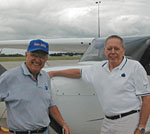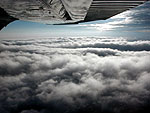By Dan Gunderson
Minnesota Public Radio
July 15, 2002
Twenty-five small airplanes leave Fargo, North Dakota on Monday morning, on the first leg of a three day race. The Marion Jayne U.S. Air Race, attracts pilots from as far away as Hawaii and London. There are also some hometown favorites.
| |
|
|
|
||
Darrol Schroeder and Alex Macdonald run through a pre-flight checklist in the cramped cockpit of a single-engine Cessna. Schroeder is at the controls, Macdonald is navigator.
The two men grew up three miles apart, on North Dakota farms. They each retired from the military with the rank of major general. Between them they've logged about 30,000 hours of flying time. They've flown some of the fastest fighter jets in the world.
But in this race, they're rookies.
Pilot skill and navigation, not power and speed will win the three-day event.
"We looked over the race book and that kind of alarmed both of us, because most of these people have been in the race once, some two or three times," says Schroeder.
| |
|
|
|
||
"Of course there's a lot of people who think with our background we'll do well," Macdonald adds. "But really this is an entirely new experience and I would be very surprised if we finished very high because we just don't know the ropes yet."
Winning the race is not about having the fastest aircraft. Each plane is assigned a handicap, based on it's size and speed. The team that beats its handicap by the widest margin, wins the race. Pilots will cover 1,900 miles in three days, flying over Minnesota, Ontario, North Dakota and South Dakota. Each leg of the course will take a few hours to complete.
To be successful, pilots must fly a straight line between checkpoints, and try to find a good tailwind. There are also a lot of rules to make sure the race is fair.
"They have a book of instructions about a quarter-inch thick," says Darrol Schroeder. "You're penalized if you do anything wrong. You lose points. Like flying over the checkpoint the wrong way or getting in someone else's way."
There are prizes, but no huge purse for the winner, it's mostly for bragging rights.
"If it's a lot of fun, regardless of where we finish and we meet a lot of nice people probably next year we're going to think seriously about doing it again," says Macdonald.
| |
|
|
|
||
Race Director Pat Purcell says the goal is to promote aviation, raise money for charity through sponsoring businesses and have a good time. Purcell says racers are highly competitive in the air. There may also be some competition at the end of each day as racers gather to swap stories.
"If you're a pilot all you have to do is see another pilot and it doesn't matter if it's a 16-year-old boy who just got his private ticket or you're a retired Airforce Colonel and a war ace," says Purcell. "You say pilot, and you two are immediately on the same wave length and you've got a bond."
The race is named in honor of Marion Jayne. Jayne is a member of the Aviation Pioneer Hall of Fame, and winner of more than 20 air races including two round-the-world contests.
Racers travel from Fargo to Thunder Bay, Ont., on Monday. Tuesday's leg takes them to Spearfish, S.D. They return to Fargo on Wednesday.
More Information


